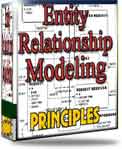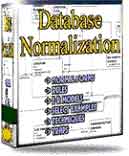 |
||
|
|
Database Glossary in Database DesignA database glossary at your disposal.The words used in database design MAY be confusing, at times: That is why I provide this database glossary for you: If you don't find the term you are uncertain about here, use my Contact page for a message, and I will include the term here.This is a "live" glossary: Whenever there exists relevant information about a term on some other page around here, the term appears as a direct link to that page. Some of the pages may be articles, short or long, others may lead you to a free eBook, and others again may offer you a payable eBook, if the term is a complex and/or lengthy one. If I do not have a relevant page for a given
term, you can blame it on me: Not writing fast enough. I will, however,
put the term in bold and give a short explanation.
A column or combination of columns, other than the primary key column(s), which may be used to uniquely identify a row in a table. The primary key is chosen from one of the candidate keys. As you can read from the article behind this term; if you have many candidate keys, you have a problem of selecting the best fit. An attribute is a part of the description of the entity. The entity itself is described by one or more attributes; together, they describe all things of importance about the entity. Example: Typhical attributes for a customer would be name, address, telephone, etc. Specific business-related information that is associated with database objects. The information can be business restrictions (allowable values), facts, or calculation rules for given business situations, e.g VAT shall be added to all products. Business rules should be applied in the completed database, either as triggers/stored procedures, or (absolutely worst case) implemented in the application code. However, if you do that, you will make your business dependent on a specific application... Each entity should have at least one candidate (that is: unique) key defined. This is in order to being able to identify each row in the table at hand. Read the above link about candidate keys: It will teach you the importance of the issue. The cardinality of an entity indicates the number of instances (zero or many) of an entity. Many describe the cardinality through relationships: One-to-one, One-to-many, Many-to-many. In addition, each end of a relationship may be optional or mandatory. The cardinality term is not restricted to relationships, however: We also try to distinguish between low and high cardinality on attributes: an attribute for GENDER will have a low cardinality (2); Male or Female. This may inflict on how we design indexes in the database. Another meaning of cardinality is to describe how many rows you have in a specific table. The physical equivalence to an attribute: In a database table, the table consists of one or more columns; together they describe all we want to know about each occurrence (record) in the table. Data Definition Language (DDL) Data Manipulation Language (DML) The language used to manipulate objects in a relational database: We only have four statements in DML: INSERT, SELECT, UPDATE and DELETE. DML provides the semantics for manipulating one or more occurrences (record) in a table in our database. It is based on a given standard, but may deviate some from vendor to vendor, especially through ‘extensions’ found valuable by the given vendor. A data model is not the model (conceptual/logical/physical) of your future or existing database: It is a generic model which you base your analysis and design upon. The relational model is one such data model. To my knowledge, there are no other data models that reflect the reality as we have to deal with it. I can not provide you with an OO-oriented data model, or an XML data model; such complete models do not exist, although some vendors are trying to make you think otherwise. A Database model is the logical conversion of an Entity Relationship model. While an ER model reflects the business case, the Database model visualizes the logical model, which in turn is the basis for the physical implementation in the form of database tables, indexes and other mechanisms in the database, necessary to construct the database in question. Database Normalization is the process of analyzing your database model to ensure that information is stored only in one place in the database, and that there are no derivates of the information within the database. A perhaps more understandable explanation of the 5 Normal Forms can be found in my eBook on Database Normalization Identifies the kind of information that an Attribute/column in an entity/table on a specific database platform represents. These are actual physical representations and are dependent on the actual RDBMS’s. The datatype should be given by the domain definition for that attribute/column. Domain A standardized definition which applies to many attributes/columns. For example, the domain MONEY may be specified as NUMBER, 15 digits long, with 2 decimals, not allowed to have a value of 0.00, and so on. Applying domain definitions to every attribute/column, eases the implementation of changes, and assures that the same kind of information is treated equally throughout the system. Any kind of information of importance to the business: Customers, Orders, Products, or whatever information we need in order to perform a certain task.Used in the building of the conseptial (business) model Column or combination of columns in a table, whose values are related to a primary key in another table. An index is a physical mechanism applied to one (or a combination of) column(s). The purpose of the index is for the database system to use the index as a look-up mechanism instead of reading the whole row. Indexes are a prime resource for optimalization (and thereby increasing speed) of searches in the database. A join relationship is a collection of information from two or more tables. The join is performed by relating columns which are foreign key columns in one table with equivalent columns which are primary key columns in the other table. MetaData 'Data about Data'. This is the documentation stored in the database repository, and which holds information about your database objects. In Oracle, for example, the table USER_TABLES holds vital information about your tables. The concept of NULL, which means "unknown value", (not the digit zero) is not a part of the relational model, but has been introduced by the different vendors. It can create unexpected problems when accessing the database (read the linked article). Each row in a database table. If you have 100 customers in your CUSTOMERS table, the table has 100 occurrences. Open DataBase Connectivity (ODBC) A general interface for communication with different vendor-specific Relational Database Systems. A column (or combination of columns) whose value(s) uniquely identify a row in a table. This has been a central consept in Relational Theory, and crucial to both identification and performance. Lately, the concept has been questioned, saying that a table should have one or more candidate keys only; however, for all practical reasons, a table should never be created before its (unique) primary key has been determined. A ref cursor is a pointing feature for use in a procedural language. The use of a ref cursor, explicit, gives you the power to navigate a result set from a SELECT statement one record at a time. It is a basic concept in Oracle, but can also be used from other procedural languages such as Java. Referential integrity deals with the governing of data consistency. We mostly think of it as keeping the relations between tables valid; that is, an order may not have a customer id that does not exist; a transaction can not be posted for an illegal (non-existent) account. A relationship is an association between two entities. For example, the relationship between the ORDERS and CUSTOMERS tables will normally be that an order is placed by ONE AND ONLY ONE customer, while a given customer MAY HAVE placed ONE OR MORE orders. This will create a link between orders and customers, and thereby generating a business rule inside the database to enforce that relationship. Structured Query Language (SQL) SQL is the industry standard language for designing and communicating with relational databases. A stored function is SQL (and procedural code, in most cases), placed in the database itself. It masks the business logic from the programmer. In addition, stored functions return only one value to the calling program, and can be used as part of DML statements and within calculations and conditional statements as a parameter. A stored procedure is SQL (and procedural code, in most cases), placed in the database itself. It masks the business logic from the programmer. In addition, stored procedures represent a powerful tool to let all programmers have a generic interface to different access mechanisms to each table in the database. The physical implementation of an entity. This is where the actual data is stored as customers, orders, products, or whatever. Each table consists of one or more columns. Trigger A trigger is a stored procedure assigned to a given table. It ‘fires’ whenever you do an operation on that table (BEFORE/AFTER INSERT/UPDATE/DELETE etc.) Triggers are powerful, performance-enhancing mechanisms in the database. The equivalent of a primary key. It may also be a candidate for creating unique indexes in addition to the primary key. View An imaginary table: A view may be constructed to give the
user/programmer access to a limited resultset from one or more tables.
It is often used for security reasons; restricting access through views.
|
Exclusive interviews with:
Free eBookSubscribe to my newsletter and get my ebook on Entity Relationship Modeling Principles as a free gift: What visitors say...
"I just stumbled accross your site looking for some normalization theory and I have to say it is fantastic.
Read more
Testimonials
I have been in the database field for 10+ years and I have never before come across such a useful site. Thank you for taking the time to put this site together." Mike, USA |
|
Theory & Practice DB Normalization Analysis Phase Database Keys DB Glossary Appl.Architecture Oracle DBA MySQL DBA SQL Server DBA Install Oracle Install SQL Server Proj.Management Oracle Constraint Programming Tips Database Normalization eBook: |
||
|
Copyright © www.databasedesign-resource.com /
All rights reserved. All information contained on this website is for informational purposes only. Disclaimer: www.databasedesign-resource.com does not warrant any company, product, service or any content contained herein. Return to top
The name Oracle is a trademark of Oracle Corporation. |
||